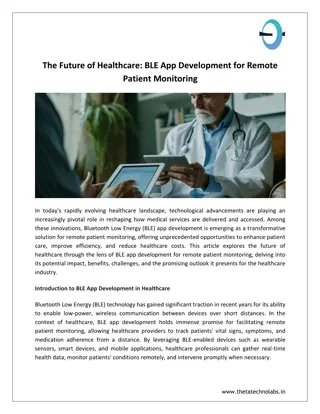
Healthcare Marketing Strategies
Explore the significance of marketing in the healthcare industry, including creating customer relationships, delivering value, and achieving long-term success through strategic marketing tactics. Learn about key components of the marketing concept and how it influences organizational goals and objectives.
Download Presentation

Please find below an Image/Link to download the presentation.
The content on the website is provided AS IS for your information and personal use only. It may not be sold, licensed, or shared on other websites without obtaining consent from the author. If you encounter any issues during the download, it is possible that the publisher has removed the file from their server.
You are allowed to download the files provided on this website for personal or commercial use, subject to the condition that they are used lawfully. All files are the property of their respective owners.
The content on the website is provided AS IS for your information and personal use only. It may not be sold, licensed, or shared on other websites without obtaining consent from the author.
E N D
Presentation Transcript
CAG UNIVERSITY 2019 2020 FALL SEMESTER MAN 429 HEALTH CARE MANAGEMENT
Chapter 6: Healthcare Marketing Learning Objectives Assess marketing and the progression of becoming a market- oriented organization Critique the critical link between strategic management and health care marketing Differentiate among the major components that are part of the marketing management process Compare and contrast several important marketing terms, including market segmentation, target markets, marketing mix, and positioning Analyze how health care managers can integrate ethics and social responsibility into marketing strategy Create marketing tactics such as using social media related to the strategic goals of a health care organization
The extent of marketing in the health care industry is enormous. Health care marketing consists of the kinds of activities a firm uses to satisfy customer needs; the approaches managers pursue to create, communicate, and deliver value in selected markets; and the means of capturing value in return. Acustomer is the purchaser of products, services, and ideas. All marketing activities should focus on the customer. In this sense, the role of health care marketing must be understood as the process of creating long-term, mutually beneficial relationships between the organization and well-defined target customers.
What is marketing? Many people mistakenly equate marketing with advertising, promotion, or selling. The American Marketing Assoc. (2013) defines marketing as the activity, set of institutions, communicating, delivering, and exchanging offerings that have value for customers, clients, partners, and societ at large . From this definition; first it places marketing in the central role of satisfying customer needs. Second, all marketing activities center on building a sustainable value-driven system for customers, stakeholders, and society. These customers can include individual health care consumers, physicians, insurers, or other organizations. Third, health care organizations and managers with a relentless focus on creating long-term customer relationships will generally achieve superior performance over those who only focus on short- term results. and processes for creating,
Key components of the Marketing Concept According to the marketing concept, an organization must create, communicate, and deliver customer value to selected target markets more effectively than its competition to achieve goals and objectives. Customer value is the difference between the benefits a consumer perceives from the purchase of a product, service, or idea and the cost to acquire those benefits. Through a coordinated set of well-defined activities, the marketing manager must do the right things at the right time to orchestrate individual strategies into a wholly integrated system. In general, an organization can be characterized as production oriented, sales oriented, or marketing oriented.
The Strategic Marketing Process The emergence of a market where sustainable distinctive advantage is based on the ability of an organization to create, communicate, and deliver customer lifetime value more effectively than its competitors is creating profound changes in the practice of health care marketing. NorthShore University Health System commissioned a market research study to understand consumer motivation. By listening to patients, they learned consumers were interested in talking about their medical conditions- not hospital services. They also learned patients identify with physicians and nurses- not hospitals.
The Strategic Marketing Process Although external uncontrollable (marketplace) and internal controllable (organizational) complexities present marketing issues, agile health care extraordinary results by keeping the customer front and center as the focal point in all marketing activities. The Figure with the Pie represents the essential components of strategic marketing. Organizations can formulate an effective marketing strategy within the context of the organization s strategic plan and in concert with other functional areas (finance, HR, etc.). Marketing relies on the strategic plan to deliver a sound and reasonable fit between the external environment and internal organizational capabilities. organizations can achieve
The development of a marketing strategy can be viewed at three main levels: 1. Establishment of a core strategy 2. Creation of the company s positioning 3. Implementation of the strategy competitive
Understanding Marketing Management Health care marketers must continually scan the external environment and conduct a situation assessment to determine the strengths, weaknesses, opportunities, and threats (SWOT Analysis) for a given offering, set of offerings, or an entire portfolio of products and services. As such, health care marketing management is the art and science of selecting target markets and creating, and delivering values to selected customers in a manner that is both sustainable and differentiated from the competition.
Segmentation, Targeting, and Positioning A market is a diverse group of organizations or individuals who have disparate needs for products and services. Market segmentation is the process of dividing the total market into groups or segments that have relatively similar needs for products and services. Segmentation is most useful when buyers in target segments have the budget, authority, need, and time with a propensity to purchase products and services. In other words, attractive healt care market segments must also be measureable and actionable. A target market consists of a more narrowly defined group of individuals or organizations with relatively similar wants and needs.
Target Market Segment Selection The combination characteristics, organization s objectives and resources must be taken into consideration. Berkowitz(2011) distinguishes between the two categories of strategies as follows: of target offering market portfolio, needs and and the the
1. Concentration strategy: This approach targets a single market in order to specialize with the objective of gaining a large share of the market. An orthodontic practice choosing to focus solely on children and adolescents as a niche market is an example. An advantageof this strategy is that specialization enable the health care provider to focus all marketing activities on creating, delivering, and sustaining long-term value to a distinct set of customers. The disadvantage is that specialization may preclude the organization from entering other attractive markets, such as treating adults in the orthodontic practice. 2. Multisegment strategy: This approach targets several segments with differentiation among the selected group of customers. For example, a general dental practice might choose to serve both children and adults, but might also offer orthodontic services.
Positioning The positioning aspect of the strategic marketing process brings health care marketing closer to tactical implementation. Once an organization determines which portion of the larger market serve, it then positions itself in the face of competition. Hence, health care organizations and providers must deliberately position the brand image and offerings in the mind of the target market. To position products or services apart from the competition, managers must determine what makes them or differentiates them and focus on these features in the marketing strategy.
Health Care Buyer Behavior Organizational Buying Behavior: The business market has been defined as all organizations that acqu re goods and services. Business-to-business organizational buyers. Consider the following examples: - Employers purchase health insurance coverage for employees. - Local, state, and national governments hire health policy consultants. - Physician practices contract with vendors of electronic health record software. - Medical devices, pharmaceuticals, and medical surgical supplies comprise a large share of virtually every hospital s total expenditures. - Group purchasing organizations facilitate the complex task of sourcing and contracting products and services for health care system. (B2B) marketing concentrates on
Health Care Buyer Behavior Consumer Buying Behavior: Consumer behavior refers to the totality of consumers decisions with respect to the acquisition, consumption, and disposition of goods, services, time, and ideas by humans over time. The study of consumer behavior seeks to understand how people select, secure, use, and dispose of products, services, experiences, or ideas to satisfy their needs. To understand consumer behavior, health care managers must draw heavily from the field of psycology. A number of psychological theories have been used to explain the consumer decision-making process.
Marketing Mix Putting the marketing strategy into practice requires attending to the controllable variables for the organization. The marketing mix consists of these four controllable P s: (1) Product: goods, services, or ideas (2) Price: value placed on the product (3) Promotion: marketing activities used to communicate to the target market, including public relations, advertising, personal selling, and integrated marketing campaigns (4) Place: the offering delivery route (e.g., a pediatric optometrist office)
Marketing Plan The marketing plan is a written document that serves to guide marketing initiatives across the organization. Promotion via Social Media One of the most common Internet activities is looking for health information. Types of Marketing Social marketing is; 1. the application of commercial marketing principles and techniques 2. used to influence behavioral change 3. focused on a specific target audience 4. used in order to promote public health 5. intended to benefit society as a whole
Marketing Plan Cause-related marketing links a for-profit company and its offeirngs to a societal issue, such as breast cancer, with the goal of building brand equity and increasing profits. Ribbon used for social and cause-related marketing
Ethics and Social Responsibility The marketing discipline must take into consideration the impact that marketing activities have on individual, group, organizational, and societal outcomes. There can be a dark side of marketing such as firms that market unhealthy products such as cigarettes or encourage behaviors such as alcohol consumption and video game addiction. In addition, there are ethical issues associated with advertising to children and vulnerable populations. Social responsibility and ethical approaches need to be learned and applied to marketing Health care leaders and their respective organizations should model ethically responsible marketing practices.






















